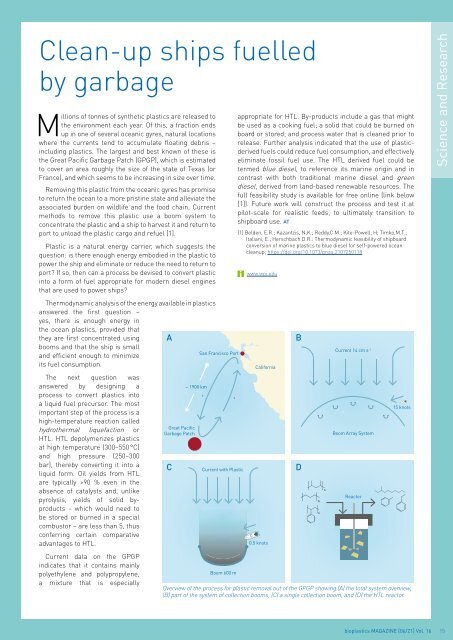Issue 06/2021
Highlights: Coating Films, Flexibles, Bags Basics: Cellulose based bioplastics
Highlights:
Coating
Films, Flexibles, Bags
Basics: Cellulose based bioplastics
Create successful ePaper yourself
Turn your PDF publications into a flip-book with our unique Google optimized e-Paper software.
Clean-up ships fuelled<br />
by garbage<br />
Millions of tonnes of synthetic plastics are released to<br />
the environment each year. Of this, a fraction ends<br />
up in one of several oceanic gyres, natural locations<br />
where the currents tend to accumulate floating debris –<br />
including plastics. The largest and best known of these is<br />
the Great Pacific Garbage Patch (GPGP), which is estimated<br />
to cover an area roughly the size of the state of Texas (or<br />
France), and which seems to be increasing in size over time.<br />
Removing this plastic from the oceanic gyres has promise<br />
to return the ocean to a more pristine state and alleviate the<br />
associated burden on wildlife and the food chain. Current<br />
methods to remove this plastic use a boom system to<br />
concentrate the plastic and a ship to harvest it and return to<br />
port to unload the plastic cargo and refuel [1].<br />
Plastic is a natural energy carrier, which suggests the<br />
question: is there enough energy embodied in the plastic to<br />
power the ship and eliminate or reduce the need to return to<br />
port? If so, then can a process be devised to convert plastic<br />
into a form of fuel appropriate for modern diesel engines<br />
that are used to power ships?<br />
Thermodynamic analysis of the energy available in plastics<br />
answered the first question –<br />
yes, there is enough energy in<br />
the ocean plastics, provided that<br />
they are first concentrated using A<br />
booms and that the ship is small<br />
and efficient enough to minimize<br />
its fuel consumption.<br />
The next question was<br />
answered by designing a<br />
process to convert plastics into<br />
a liquid fuel precursor. The most<br />
important step of the process is a<br />
high-temperature reaction called<br />
hydrothermal liquefaction or<br />
HTL. HTL depolymerizes plastics<br />
at high temperature (300–550 °C)<br />
and high pressure (250–300<br />
bar), thereby converting it into a<br />
liquid form. Oil yields from HTL<br />
are typically >90 % even in the<br />
absence of catalysts and, unlike<br />
pyrolysis, yields of solid byproducts<br />
– which would need to<br />
be stored or burned in a special<br />
combustor – are less than 5, thus<br />
conferring certain comparative<br />
advantages to HTL.<br />
Current data on the GPGP<br />
indicates that it contains mainly<br />
polyethylene and polypropylene,<br />
a mixture that is especially<br />
Great Pacific<br />
Garbage Patch<br />
C<br />
~ 1900 km<br />
San Francisco Port<br />
Current with Plastic<br />
Boom 600 m<br />
appropriate for HTL. By-products include a gas that might<br />
be used as a cooking fuel; a solid that could be burned on<br />
board or stored; and process water that is cleaned prior to<br />
release. Further analysis indicated that the use of plasticderived<br />
fuels could reduce fuel consumption, and effectively<br />
eliminate fossil fuel use. The HTL derived fuel could be<br />
termed blue diesel, to reference its marine origin and in<br />
contrast with both traditional marine diesel and green<br />
diesel, derived from land-based renewable resources. The<br />
full feasibility study is available for free online (link below<br />
[1]). Future work will construct the process and test it at<br />
pilot-scale for realistic feeds, to ultimately transition to<br />
shipboard use. AT<br />
[1] Belden, E.R.; Kazantzis, N.K.; Reddy,C.M.; Kite-Powell, H; Timko,M.T.;<br />
Italiani, E.; Herschbach D.R.: Thermodynamic feasibility of shipboard<br />
conversion of marine plastics to blue diesel for self-powered ocean<br />
cleanup; https://doi.org/10.1073/pnas.2107250118<br />
www.wpi.edu<br />
California<br />
0.5 knots<br />
B<br />
D<br />
Current 14 cm s -1<br />
Boom Array System<br />
Reactor<br />
15 knots<br />
Overview of the process for plastic removal out of the GPGP showing (A) the total system overview,<br />
(B) part of the system of collection booms, (C) a single collection boom, and (D) the HTL reactor.<br />
Science and Research<br />
San Francisco Port<br />
Current bioplastics 14 cm s MAGAZINE [<strong>06</strong>/21] Vol. 16 15<br />
-1

















